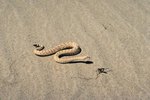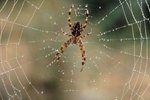
Black widow spiders go into a state known as overwintering in cold locations. It's similar to a bear hibernating. The spider's metabolic rate slows to conserve energy. Baby black widows hatch by the hundreds as tiny white spiders called nymphs. In early adulthood they overwinter in protected areas in nature or in buildings, such as barns and storage sheds.
Black Widow Lifestyle
A bite from a female black widow can be fatal. The female has a red hourglass on her belly. She produces up to 900 eggs at a time. The enormous number of young are necessary for survival because the baby spiders eat each other. The male black widow is about 25 percent smaller and lighter in color. He doesn't have the red hourglass and doesn't produce venom. Black widows prefer to live in dark, undisturbed areas, such as in brush, tree hollows and outbuildings. They don't attack unless you're disrupting the spider or her web.
Winter Survival
They may enter homes and other inhabited buildings in winter in locations where the weather turns cold. Black widow venom is 15 times more powerful than that of a rattlesnake, and about 5 percent of black widow bites are fatal, according to the North Carolina University website. Winters don't harm black widows because they are adapted to live through cold months in a low-energy state. They tuck in their legs and become dormant.
References
Resources
Photo Credits
-
Ian Waldie/Getty Images News/Getty Images
Writer Bio
Gryphon Adams began publishing in 1985. He contributed to the "San Francisco Chronicle" and "Dark Voices." Adams writes about a variety of topics, including teaching, floral design, landscaping and home furnishings. Adams is a certified health educator and a massage practitioner. He received his Master of Fine Arts at San Francisco State University.




